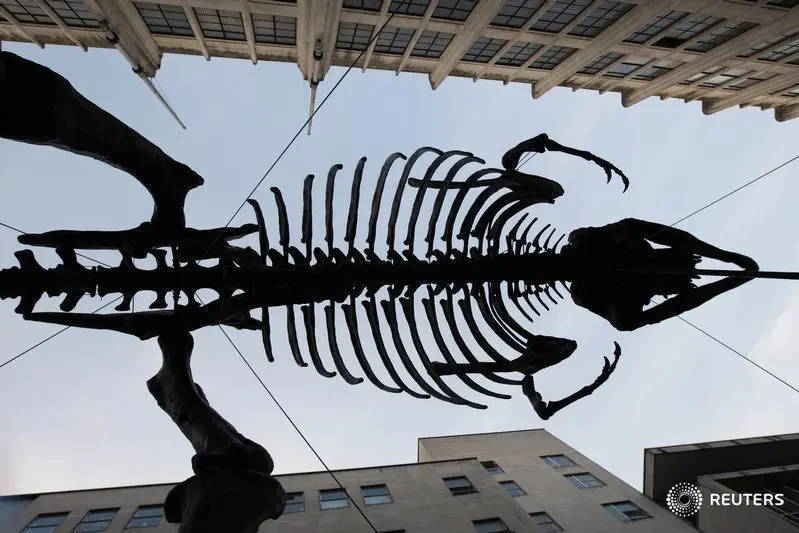PHOTO
By Estelle Shirbon
LONDON, July 28 (Reuters) - Exhibits including dinosaur skeletons and rare taxidermy specimens are being destroyed because of scorching temperatures in an Oxford museum after it restored its 19th century glass roof, letting in more sunlight.
Home of the world's most complete dodo remains, the Oxford University Museum of Natural History now plans to apply a solar reflective film to the glass roof to reduce temperatures which have peaked at 44 degrees Celsius (111.2F).
The museum, founded in 1860, cleaned and repaired its grand Victorian glass roof in 2012-2013 at a cost of 2 million pounds ($2.6 million), a process that included the removal of an old anti-ultra violet (UV) protective film that had become degraded.
"The removal of the film together with the removal of dirt and grime has resulted in a significant increase in UV levels," the museum said in a planning application to Oxford City Council, which has to approve the plan to solve the problem.
It said the intense heat was affecting visitors to the museum, and posed a significant safety risk particularly to young children and elderly people.
"The extreme light and UV levels are also causing rapid and irreversible damage to specimens, in short they are being destroyed," it said, adding that scientifically important whale skeletons were among the exhibits at risk.
The solution proposed is only a first step. The new anti-UV film will reduce UV radiation by 99.9 percent, Oxford University said, but will do little to lower the temperature, which is also a factor in the damage to exhibits.
To bring the mercury down, the university is working on plans for a new air-conditioning system.
The museum's collections are listed by the British government as being of national and international importance.
Its biggest attraction, known as the Oxford dodo, are the mummified head and foot of one of the flightless birds, which lived on the Island of Mauritius in the Indian Ocean until they became extinct by 1680.
The museum also displays a new reconstruction of a dodo, based on extensive scientific investigations, and a painting of a dodo by the Flemish artist Jan Savery dating back to 1651.
The painting is thought to have influenced Lewis Carroll, author of "Alice's Adventures in Wonderland", who lived in Oxford and visited the museum. A dodo is one of the memorable characters in the world-famous book.
(editing by Giles Elgood) ((estelle.shirbon@thomsonreuters.com; +44 207 542 1346))
LONDON, July 28 (Reuters) - Exhibits including dinosaur skeletons and rare taxidermy specimens are being destroyed because of scorching temperatures in an Oxford museum after it restored its 19th century glass roof, letting in more sunlight.
Home of the world's most complete dodo remains, the Oxford University Museum of Natural History now plans to apply a solar reflective film to the glass roof to reduce temperatures which have peaked at 44 degrees Celsius (111.2F).
The museum, founded in 1860, cleaned and repaired its grand Victorian glass roof in 2012-2013 at a cost of 2 million pounds ($2.6 million), a process that included the removal of an old anti-ultra violet (UV) protective film that had become degraded.
"The removal of the film together with the removal of dirt and grime has resulted in a significant increase in UV levels," the museum said in a planning application to Oxford City Council, which has to approve the plan to solve the problem.
It said the intense heat was affecting visitors to the museum, and posed a significant safety risk particularly to young children and elderly people.
"The extreme light and UV levels are also causing rapid and irreversible damage to specimens, in short they are being destroyed," it said, adding that scientifically important whale skeletons were among the exhibits at risk.
The solution proposed is only a first step. The new anti-UV film will reduce UV radiation by 99.9 percent, Oxford University said, but will do little to lower the temperature, which is also a factor in the damage to exhibits.
To bring the mercury down, the university is working on plans for a new air-conditioning system.
The museum's collections are listed by the British government as being of national and international importance.
Its biggest attraction, known as the Oxford dodo, are the mummified head and foot of one of the flightless birds, which lived on the Island of Mauritius in the Indian Ocean until they became extinct by 1680.
The museum also displays a new reconstruction of a dodo, based on extensive scientific investigations, and a painting of a dodo by the Flemish artist Jan Savery dating back to 1651.
The painting is thought to have influenced Lewis Carroll, author of "Alice's Adventures in Wonderland", who lived in Oxford and visited the museum. A dodo is one of the memorable characters in the world-famous book.
(editing by Giles Elgood) ((estelle.shirbon@thomsonreuters.com; +44 207 542 1346))











